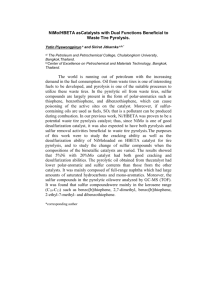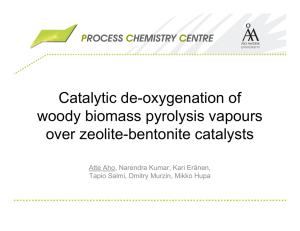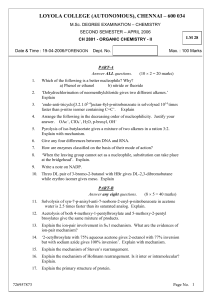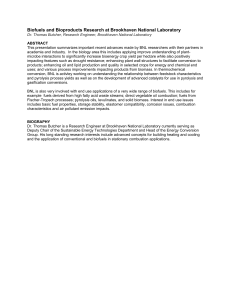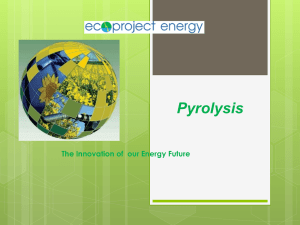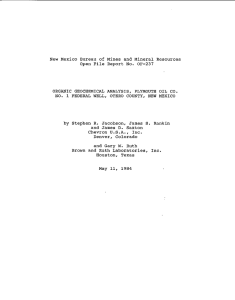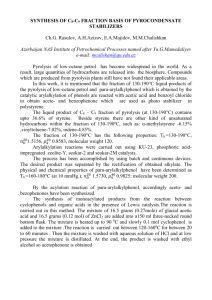Thermo-Catalytic Pyrolysis of Waste Plastics from End of Life Vehicle
advertisement
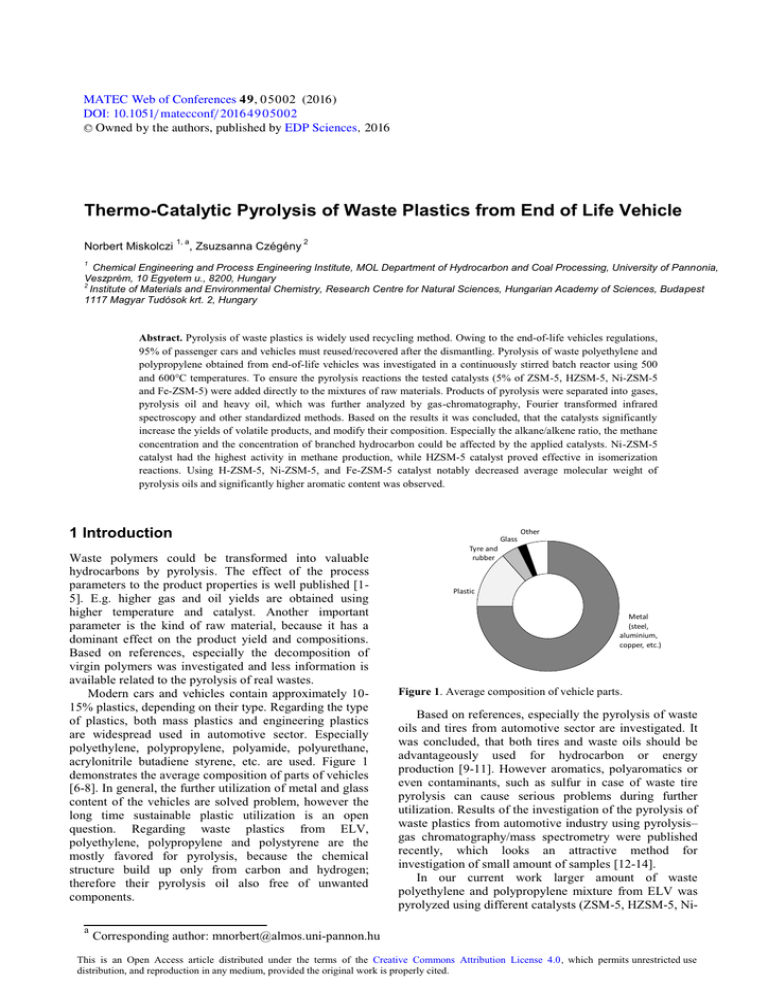
MATEC Web of Conferences 4 9 , 0 5 0 02 (2016 ) DOI: 10.1051/ m atecconf/ 2016 4 9 0 5 0 02 C Owned by the authors, published by EDP Sciences, 2016 Thermo-Catalytic Pyrolysis of Waste Plastics from End of Life Vehicle Norbert Miskolczi 1, a , Zsuzsanna Czégény 2 1 Chemical Engineering and Process Engineering Institute, MOL Department of Hydrocarbon and Coal Processing, University of Pannonia, Veszprém, 10 Egyetem u., 8200, Hungary Institute of Materials and Environmental Chemistry, Research Centre for Natural Sciences, Hungarian Academy of Sciences, Budapest 1117 Magyar Tudósok krt. 2, Hungary 2 Abstract. Pyrolysis of waste plastics is widely used recycling method. Owing to the end-of-life vehicles regulations, 95% of passenger cars and vehicles must reused/recovered after the dismantling. Pyrolysis of waste polyethylene and polypropylene obtained from end-of-life vehicles was investigated in a continuously stirred batch reactor using 500 and 600°C temperatures. To ensure the pyrolysis reactions the tested catalysts (5% of ZSM-5, HZSM-5, Ni-ZSM-5 and Fe-ZSM-5) were added directly to the mixtures of raw materials. Products of pyrolysis were separated into gases, pyrolysis oil and heavy oil, which was further analyzed by gas-chromatography, Fourier transformed infrared spectroscopy and other standardized methods. Based on the results it was concluded, that the catalysts significantly increase the yields of volatile products, and modify their composition. Especially the alkane/alkene ratio, the methane concentration and the concentration of branched hydrocarbon could be affected by the applied catalysts. Ni-ZSM-5 catalyst had the highest activity in methane production, while HZSM-5 catalyst proved effective in isomerization reactions. Using H-ZSM-5, Ni-ZSM-5, and Fe-ZSM-5 catalyst notably decreased average molecular weight of pyrolysis oils and significantly higher aromatic content was observed. 1 Introduction Waste polymers could be transformed into valuable hydrocarbons by pyrolysis. The effect of the process parameters to the product properties is well published [15]. E.g. higher gas and oil yields are obtained using higher temperature and catalyst. Another important parameter is the kind of raw material, because it has a dominant effect on the product yield and compositions. Based on references, especially the decomposition of virgin polymers was investigated and less information is available related to the pyrolysis of real wastes. Modern cars and vehicles contain approximately 1015% plastics, depending on their type. Regarding the type of plastics, both mass plastics and engineering plastics are widespread used in automotive sector. Especially polyethylene, polypropylene, polyamide, polyurethane, acrylonitrile butadiene styrene, etc. are used. Figure 1 demonstrates the average composition of parts of vehicles [6-8]. In general, the further utilization of metal and glass content of the vehicles are solved problem, however the long time sustainable plastic utilization is an open question. Regarding waste plastics from ELV, polyethylene, polypropylene and polystyrene are the mostly favored for pyrolysis, because the chemical structure build up only from carbon and hydrogen; therefore their pyrolysis oil also free of unwanted components. a Glass Other Tyre and rubber Plastic Metal (steel, aluminium, copper, etc.) Figure 1. Average composition of vehicle parts. Based on references, especially the pyrolysis of waste oils and tires from automotive sector are investigated. It was concluded, that both tires and waste oils should be advantageously used for hydrocarbon or energy production [9-11]. However aromatics, polyaromatics or even contaminants, such as sulfur in case of waste tire pyrolysis can cause serious problems during further utilization. Results of the investigation of the pyrolysis of waste plastics from automotive industry using pyrolysis– gas chromatography/mass spectrometry were published recently, which looks an attractive method for investigation of small amount of samples [12-14]. In our current work larger amount of waste polyethylene and polypropylene mixture from ELV was pyrolyzed using different catalysts (ZSM-5, HZSM-5, Ni- Corresponding author: mnorbert@almos.uni-pannon.hu This is an Open Access article distributed under the terms of the Creative Commons Attribution License 4.0, which permits XQUHVWULFWHGXVH distribution, and reproduction in any medium, provided the original work is properly cited. MATEC Web of Conferences Waste high density polyethylene (HDPE), low density polyethylene (LDPE) and polypropylene (PP) were used as raw materials in our current work from ELV dismantling. ELV wastes contained 4.85% ash, especially glass fiber and 2.17% volatiles, therefore the combustibles were 92.98%. Different catalysts were used for modifying the pyrolysis characteristic and properties of the products: ZSM-5, HZSM-5, Ni-ZSM-5 and Fe-ZSM-5. Wet impregnation was used for Ni-ZSM-5 and Fe-ZSM-5 synthesis, using Ni(NO3)2x6H2O and Fe(NO3)3x9H2O, respectively, while 1M NH4NO3 was used for HZSM-5 synthesis at 80°C. Catalysts were dried for 10 hours at 110°C, and then each of them was calcined at 600°C for 3 hours. Gases were analyzed by DANI GC using 50 m x 0.32 mm fused silica column with Al2O3/KCl coating. Pyrolysis oils were also analyzed by gaschromatography using a 30m x 0.32mm Rtx®-1 (nonpolar phase; Crossbond® dimethyl polysiloxane) column. The saturated/unsaturated ratio of the oils was followed by a TENSOR 27 type FTIR spectrometer (resolution: 2 cm-1, illumination: SiC Globar light, monocromator: Littrow prism, detector: RT-DLaTGS (Deutero L-α-Alanine Triglycin-Sulphate) type detector with KBr window) in the 4000-400 cm-1 wave number ranges. Volatile characteristic of pyrolysis oil was determined by Engler distillation test (ASTM-D 1078), while the density was measured according to MSZ EN ISO 12185 standard. Heavy oil fractions were analyzed by the following methods: flash point determination (ISO 2719:2002 and MSZ 15967:1979), determination viscosity (MSZ ISO 3105:1998), melting point determination (MSZ 3252:1973), density measurement (MSZ EN 1285:1996), and heating value (MSZ 24000-5:1978). 2.2 Apparatus for waste plastic pyrolysis 3 Results and discussion ZSM-5 and Fe-ZSM-5) in a continuously stirred batch reactor using 500 and 600°C temperature. 2 Material and methods 2.1 Raw materials A stainless steel continuously stirred batch reactor was used for pyrolysis of waste plastics from ELV using temperatures of 500 and 600°C. The schematic layout of the pyrolysis rig is shown in Figure 2. Gases Nitrogen E-1 E-2 Cooling water TT Pyrolysis oil 3.1 Product yields Gases, pyrolysis oil and heavy oil (together with solid char) had been obtained from pyrolysis experiments; product yields are shown in Figure 3/a and b. Based on results, it is clear, that higher yields of gases and pyrolysis oil were obtained at higher temperature using 15 min reaction time, than that of at lower temperature after 25min pyrolysis, which was attributed to the higher thermal stability of C-C bonds at lower temperature. Catalysts also had a significant effect to the yields of product. Each of them could increase both the gaseous and pyrolysis oil yields. TC Gases Pyrolysis oil Heavy oil 100 Product yield, % Heavy oil/Char Figure 2. Batch apparatus for ELV waste plastic pyrolysis. 300g of raw materials and 5% of catalysts were weighted into the reactor. Then the reactor top section was placed and valve for nitrogen flush was opened. The temperature increased to the set value in 15 minutes. The temperature was measured on the reactor wall and controlled by a computer programmed controller. Mixtures of the decomposed hydrocarbons went through a condenser and then it was separated into gaseous and pyrolysis oil for further analysis. 75 50 25 0 No- catalyst ZSM-5 HZSM-5 Ni-ZSM-5 Fe-ZSM-5 Figure 3/a. Product yields obtained at 500°C after 25min reaction time. 2.3 Methods 05002-p.2 ICCCP 2016 Gases Pyrolysis oil be decreased to 0.55 and 0.75, respectively. It is clear that the effect of the catalyst was more significant at lower temperature. The isomerisation of main carbon frame was moderate using ZSM-5. However, significant isomerisation effect was concluded using HZSM-5, because the non-branched/branched ratio could be changed from 4.34 to 1.06 at 500°C, while from 4.11 to 0.79 at 600°C temperature. Therefore the isomerisation effect of HZSM-5 catalyst was more significant at higher temperature. Heavy oil Product yield, % 100 75 50 25 100 0 No- catalyst ZSM-5 HZSM-5 Ni-ZSM-5 Fe-ZSM-5 The summarized yields of gases and pyrolysis oil was 34.7% and 62.2% at 500°(after 25min.) and 600°C (after 15min.), respectively. HZSM-5 catalyst showed the highest activity in yield increasing of gases and pyrolyis oil. The yield of pyrolysis oil was 40.3% and 17.2% gases were found at 500°C or 52.7% pyrolysis oil and 25.7% gases at 600°C using ZSM-5 catalyst. Both could be further increase using HZSM-5 catalyst, from 17.2% to 31.8% at 500°C and from 15.9% to 25.7% at 600°C in case of gases, while only 2-5% increasing was measured regarding pyrolysis oil using HZSM-5. It means that the protonated form of ZSM-5 catalyst had activity especially in increasing of gaseous products, which was the consequence of the relatively small pore size and large microporous surface are of ZSM-5 zeolite structure. NiZSM-5 and Fe-ZSM-5 had similar affect on the yields of gases and pyrolysis oil as ZSM-5 catalyst, but the yield of gaseous products was higher (25.6% and 21.3% at 500°C and 32.5% and 34.2% at 600°C). Results also well show, that the volatile yield was higher at lower temperature, than that of using higher pyrolysis temperature, in case of each investigated catalyst. It refers that the radical initiated thermal cracking was more dominant at higher temperature, than the catalytic cracking with ionic mechanics. 3.2 Gases Compositions of gases are shown in Figure 4/a and b. Gases contained aliphatic olefins, aliphatic paraffins, branched olefins, and branched hydrocarbons with carbon atoms up to six. Without catalysts the amount of n-alkanes and nalkenes are 43.5% and 31.1% at 500°C, while these values are 29.5% and 41.9% at 600°C, respectively. It means that higher n-alkane/n-alkene ratio was found at lower temperature, which was the consequence of more dominant reactions at 600°C. -scission is a well known decomposition mechanism of saturated hydrocarbon chain polymers, leading the formation of vinyl group terminated product. This decomposition route seems more significant at higher temperature. ZSM-5 catalyst increased especially the alkenes content, both branched and non-branched. E.g. the ratio of alkane/alkene was 1.3 and 0.78 at 500°C and 600°C, respectively; which could Branched alkene Branched alkane 50 n-alkene n-alkane Methane 25 0 No- catalyst ZSM-5 HZSM-5 Ni-ZSM-5 Fe-ZSM-5 Figure 4/a.Composition of gases at 500°C after 25min reaction time. 100 75 Composition, % Figure 3/b. Product yields at 600°C after 15min reaction time. Composition, % 75 Branched alkene Branched alkane 50 n-alkene n-alkane Methane 25 0 No- catalyst ZSM-5 HZSM-5 Ni-ZSM-5 Fe-ZSM-5 Figure 4/b.Composition of gases at 600°C after 15min reaction time. Regarding HZSM-5 and Ni-ZSM-5 catalyst, increasing methane concentration was observed at higher temperature. Fe-ZSM-5 catalyst showed also an activity in olefin production reactions, but only at 500°C, while at 600°C the alkane/alkene ratio did not changed significantly comparing to the ratio obtained without catalyst. The methane concentration was 8.2% and 11.2% without catalyst at 500°C and 600°C, respectively. Those values could be increased to 28.7% and 34.7% by the using of Ni-ZSM-5 catalyst or 24.5% and 32.9% using HZSM-5 catalyst at 500°C and 600°C, respectively. 3.3 Pyrolysis oil The composition of pyrolysis oil was investigated by gaschromatography. The yield of n-alkane, n-alkene, branched alkane, branched alkene, cyclic and aromatic components were summarized, and presented in Figures 5/a and b. The pyrolysis oil contained only n-alkane, n- 05002-p.3 MATEC Web of Conferences Aromatic/Cyclic Branched (alkane+alkene) 5 and Ni-ZSM-5 catalysts: 27.3% and 26.1% at 500°C or 41.6% and 39.2% at 600°C. Figure 6 shows the ratio of alkanes and alkenes at 500°C and 600°C. As data shows, the ratios of saturated and unsaturated hydrocarbons were 1.64 and 1.19 without catalysts using 500°C and 600°C pyrolysis temperatures. The ratio of the unsaturated and saturated hydrocarbon yield could be increased by catalysts; especially Ni-ZSM5 catalyst showed high activity in olefin production with ratios of 0.32 (at 500°C) and 0.31 (at 600°C). Transition metal containing catalysts has high activity in hydrogenation/dehydrogenation reactions, therefore alkenes were formed by dehydrogenation reactions of saturated hydrocarbon. Regarding the effect of temperature, results also well show that lower ratio was found at 600°C, which was caused by the higher -scission reactions. Especially the catalyst free pyrolysis have resulted significantly lower value of ratio at higher temperature, because it was 1.94 at 500°C and 1.19 at 600°C. This phenomenon was attributed to the cracking of more C-C bonds at higher temperature. 1,8 1,5 Alakane/Alkene ratio alkene, branched alkane and branched alkene when was pyrolysed without catalyst at lower temperature, while 14.2% aromatics and cyclic compounds was measured in the oil fraction obtained at 600°C. According to the literature, the cyclization and aromatization reactions became favourable at higher pyrolysis temperatures. In the presence of all investigated catalysts the yields of aromatics, cyclic and branched compounds significantly increased. It is interesting result, that the isomerisation effect of the catalysts was lower at higher temperature. The concentration of branched hydrocarbons obtained without catalyst was 27.9% and 26.4% at 500°C and 600°C, respectively. Pyrolysis oils obtained by experiments at 500°C contained 41.7%, 57.2%, 52.2% and 48.1% branched compounds using ZSM-5, HZSM-5, Ni-ZSM-5 and Fe-ZSM-5 catalysts, respectively. Using 600°C pyrolysis temperatures, that value was 33.1%, 42.5%, 40.3% and 42.9% following the same catalyst order. It means that the isomerisation efficiency of catalysts was higher at lower temperature. Probably due to the catalyst deactivation, the reaction rate of the thermal cracking was higher, than the rate of the ionic mechanism catalytic reactions at higher temperature. The coke formation is increasing with pyrolysis temperature, and the coke should be deposited on the catalyst surface, decreasing the catalyst activity. n-alkane+n-alkene Product yield, % 100 75 1,2 at 500°C 0,9 at 600°C 0,6 0,3 50 0 No- catalyst ZSM-5 HZSM-5 Ni-ZSM-5 Fe-ZSM-5 25 Figure 6. Alkane/alkene ratio. 0 No- catalyst ZSM-5 HZSM-5 Ni-ZSM-5 Other properties of pyrolysis oils are summarized in Table 1, such as density, average molecular weight and boiling point ranges. Based on volatile test, pyrolysis oil contained hydrocarbons in gasoline and middle distillate boiling point ranges (22-331°C). Fe-ZSM-5 Figure 5/a.Composition of pyrolysis at 500°C after 25min reaction time. Aromatic/Cyclic Branched (alkane+alkene) n-alkane+n-alkene Table 1/a. Other properties of pyrolysis oils obtained at 500°C Product yield, % 100 75 Property 50 Density at 20°C, g/cm3 Average molecular weight, g/mol Boiling points, °C IBP 25 0 No- catalyst ZSM-5 HZSM-5 Ni-ZSM-5 Fe-ZSM-5 Figure 5/b. Composition of pyrolysis oils at 600°C after 15min reaction time. Regarding aromatization it could be concluded, that the concentration of aromatics and cyclic compounds was nearly double at 600°C, than that of obtained at 500°C. The highest aromatic content was measured over HZSM- 05002-p.4 Nocatal yst ZSM5 HZSM -5 NiZSM5 FeZSM5 0.802 0.741 0.728 0.746 0.748 221 137 116 142 149 25 25 24 26 22 50% 209 157 142 166 168 FBP 326 286 287 285 288 ICCCP 2016 The density of pyrolysis oils was 0.802g/cm3 and 0.788g/cm3 at 500 and 600°C. It is clear that more C-C bonds of the main carbon chain should be cracked at higher temperature; therefore the density of pyrolysis oil was lower at higher temperature. Catalysts also decreased the average molecular weight of the pyrolysis oils, especially using HZSM-5 catalyst. E.g. without catalyst the average molecular weight was 221g/mol, while using HZSM-5 at 500°C it decreased to 116g/mol. On the other hand both density and molecular weight decreased at 600°C, comparing to 500°C pyrolysis temperature. Similar trend was observed regarding the boiling point ranges, because it was found that larger distillation volume belongs to same boiling points using catalysts than without them. Table 1/b. Other properties of pyrolysis oils obtained at 600°C Property Density at 20°C, g/cm3 Average molecular weight, g/mol Boiling points, °C IBP Nocataly st ZSM -5 HZSM5 NiZSM -5 FeZSM -5 0.788 0.735 0.722 0.730 0.738 203 124 102 120 Table 2/a. Main properties of pyrolysis oils obtained at 500°C Property Apparence Density*, g/cm3 Melting point, °C Flash point, °C Heating value, MJ/kg Viscosity* *, mm2/s Nocataly st Dark brown solid Light brown solid HZSM5 Light brown solid NiZSM5 Light brown solid FeZSM5 Light brown solid 0.847 0.826 0.823 0.830 0.839 56 51 46 51 53 208 184 175 179 197 40.9 41.1 40.5 40.7 41.0 5.2 4.5 4.2 4.3 4.4 * at 20°C, ** at 70°C Table 2/b. Main properties of pyrolysis oils obtained at 600°C Property Nocatalyst ZSM5 NiZSM-5 Apparence Light brown solid Light brown solid Light brown solid FeZSM5 Light brown solid 0.831 0.801 0.914 0.809 45 39 39 40 195 189 187 190 41.0 41.1 41.4 41.2 4.6 3.8 3.6 3.7 126 25 27 22 24 25 50% 199 151 137 149 160 FBP 331 275 273 278 279 ZSM5 Density*, g/cm3 Melting point, °C Flash point, °C Heating value, MJ/kg Viscosity**, mm2/s 3.4 Heavy oil/Char Heavy oil was the bottom product of pyrolysis obtained from the pyrolyis reactor at the end of reaction. This fraction was viscous light or dark brown products. In general they were solid at room temperature, because the melting point was in the range of 39 and 56°C. Table 2/a and 2/b summarizes the main properties of heavy oil obtained by pyrolysis at 500 and 600°C. Because of more C-C scission, heavy oil have lower density, melting point, and flash point obtained at 600°C, than 500°C, furthermore the listed properties were also lower using catalysts. Heating values changed between 40.5 and 41.1MJ/kg at 500°C or between 41.0 and 41.4MJ/kg at 600°C. It means, that heavy oil had enough high heating values for their further fuel-like utilization, especially for heat, steam or even electricity production. Pyrolysis in the presence of HZSM-5 catalyst resulted the lowest lower density, melting point, and flash point, which was attributed to the cracking reactions on the large surface of HZSM-5 and its high acidity at 500°C. Experiments over HZSM-5 catalyst at 600°C did not result heavy oils product, only char, because the catalyst was too active and fully cracked the polymer main chain. * at 20°C, ** at 70°C 4 Conclusion Waste plastics from ELV dismantling have been pyrolyzed in a continuously stirred batch reactor at 500 and 600°C using different catalysts. x Significant increasing in gases and pyrolysis oils was found using modified ZSM-5 catalysts. HZSM-5 catalyst had high activity in formation of gaseous product. x High concentration of methane was found using HZSM-5 and Ni-ZSM-5 catalysts. x Mainly branched hydrocarbons were obtained over HZSM-5 catalyst, which was the consequence of the isomerization effect. x ZSM-5 and Fe-ZSM-5 catalyst had high activity in formation of unsaturated hydrocarbons. x The pyrolysis oil contained n-alkane, n-alkene, branched alkane, branched alkene, cyclic and aromatic hydrocarbons, and the composition was affected by 05002-p.5 MATEC Web of Conferences catalysts, especially the aromatic and hydrocarbon content could be increased. branched 5. 6. 7. Acknowledgment The authors acknowledge to the National Office for Research and Innovation (NKTH), assistance granted under the Hungarian-Indian (KTIA-DST) R&D&I Program (TÉT_13_DST-1-2014-0003). 8. 9. 10. References 11. 1. 2. 3. 4. A. López, I. de Marco, B. M. Caballero, M. F. Laresgoiti, A. Adrados, A. Torres, Waste Manage, 31, 1973 (2011) S. S. Lam, A. D. Russell, C. L. Lee, H. A. Chase, Fuel, 92, 327 (2012) R. Aguado, G. Elordi, A. Arrizabalaga, M. Artetxe, J. Bilbao, M. Olazar, Chem. Eng. J. 254, 357 (2014) M. K. Harder, O.T. Forton, J. Anal. App. Pyrol., 79, 387 (2007) 12. 13. 14. 05002-p.6 P. T. Williams, S. Besler, D. T. Taylor, Fuel, 69, 1474 (1990) http://www.idis2.com/ (downloaded at 10 Nov. 2015) http://www.gov.scot/Publications/2013/12/9124/9 (downloaded at 10 Nov. 2015) http://www.nist.gov/lightweighting/ncalfeature.cfm (downloaded at 10 Nov.2015) S. S. Lam, A. D. Russell, C. L. Lee, S. K. Lam, H. A. Chase, Intern. Journal of Hydrogen Energ., 37, 5011 (2012) J. H. Chen, K. S. Chen, L. Y. Tong, J. of Hazard. Mat., 84, 43 (2001) J. D. Martínez, J. Rodríguez-Fernández, J. SánchezValdepeñas, R. Murillo, T. García, Fuel, 115, 490 (2014) B. Plage, A-D. Berg, S. Luhn, Foren. Science Intern., 177, 146 (2008) P. Kusch, V. Obst, D. Schroeder-Obst, W. Fink, G. Knupp, J. Steinhaus Eng. Failure Analysis, 35, 114 (2013) J. Zięba-Palus, G. Zadora, J. M. Milczarek, P. Kościelniak, J. of Chrom. A, 1179, 41 (2008)
